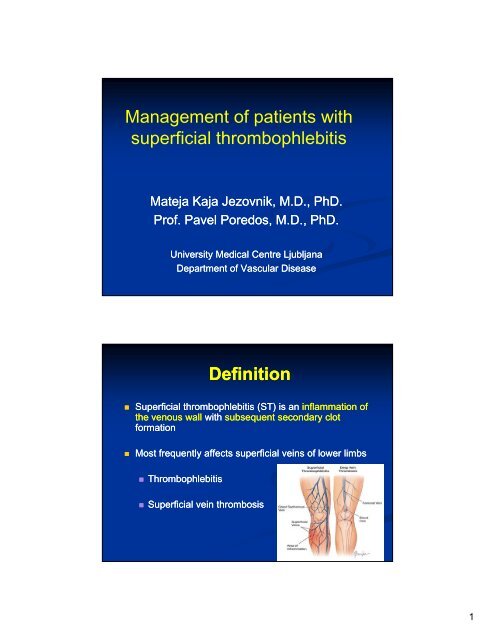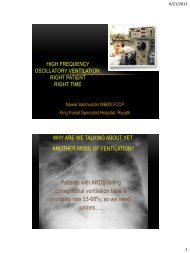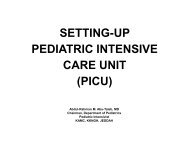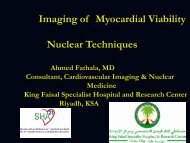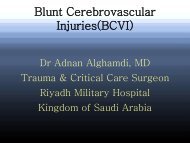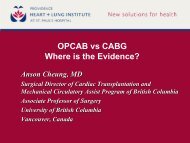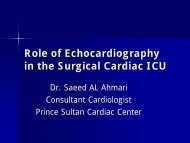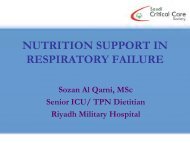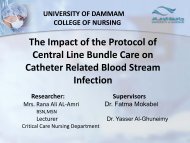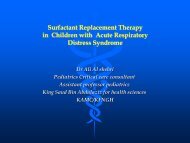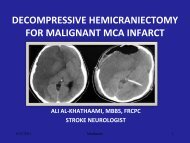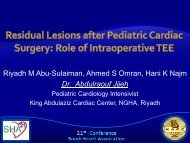Management of patients with superficial ... - RM Solutions
Management of patients with superficial ... - RM Solutions
Management of patients with superficial ... - RM Solutions
Create successful ePaper yourself
Turn your PDF publications into a flip-book with our unique Google optimized e-Paper software.
<strong>Management</strong> <strong>of</strong> <strong>patients</strong> <strong>with</strong><br />
<strong>superficial</strong> thrombophlebitis<br />
Mateja Kaja Jezovnik, M.D., PhD.<br />
Pr<strong>of</strong>. Pavel Poredos, M.D., PhD.<br />
University Medical Centre Ljubljana<br />
Department <strong>of</strong> Vascular Disease<br />
Definition<br />
• Superficial thrombophlebitis (ST) is an inflammation <strong>of</strong><br />
the venous wall <strong>with</strong> subsequent secondary clot<br />
formation<br />
• Most frequently affects <strong>superficial</strong> veins <strong>of</strong> lower limbs<br />
• Thrombophlebitis<br />
• Superficial vein thrombosis<br />
1
Clinical presentation<br />
REDNESS<br />
PAIN<br />
EDEMA<br />
WA<strong>RM</strong> SKIN<br />
Epidemiology<br />
• Incidence in the general population: 3-11%<br />
May be underestimated t d (pts <strong>with</strong> minor symptoms,<br />
not present for medical attention)<br />
• Female/male ratio: 6 to 4<br />
• Mean age <strong>of</strong> presentation: 60 yrs<br />
• Often two or more factors have to be present<br />
• Age - the older the patient, the higher the prevalence<br />
DeWeese, 1991; Nordstrom 1992, Ramelet 2008<br />
2
Etiology<br />
• Hypercoagulability<br />
• Cancer<br />
• Pregnancy, puerperium, oral contraceptives, hormone<br />
replacement therapy<br />
• Antiphospholipid syndrome<br />
• Thrombophilia<br />
• Reduced blood flow<br />
• Varicosities – injury <strong>of</strong> the venous valves<br />
• immobility<br />
• Damage <strong>of</strong> the vessel wall<br />
• Surgical procedures, trauma, i.v. catheters<br />
t<br />
• Other<br />
• AGE > 60 years<br />
• OBESITAS<br />
• History <strong>of</strong> VTE or SF<br />
Virchow<br />
triad<br />
Leon LR Jr et al. Perspect Vasc Surg Endvasc Ther, 2005<br />
Primary Superficial<br />
Thrombophlebitis<br />
• Pathogenesis es s is not known, however e there e are<br />
some supposed pathogenetic mechanisms:<br />
• Damage - inflammation<br />
• Varicose veins - VARICOPHLEBITIS (4 - 59%, bilateral 5<br />
– 10%)<br />
• Hypercoagulable states<br />
• Prevalence <strong>of</strong> hypercoagulable state t in ST is high<br />
h<br />
(up to 72% in <strong>patients</strong> <strong>with</strong>out varicose veins)<br />
• Factor V Leiden Mutation, Factor II G20210A<br />
mutation, antithrombin, protein C and S<br />
deficiency<br />
3
Secondary Superficial<br />
Thrombophlebitis<br />
• accompanied by systemic (inflammatory)<br />
disease and is related to the damage <strong>of</strong> the<br />
vascular wall<br />
• Mb. Bürger<br />
• Behçet’s et’s disease<br />
• Vasculitis and rheumatic syndromes (APLS)<br />
• Malignant tumours<br />
• “SEPTIC” TF ASSOCIATED WITH VENOUS CATHETERS (i.v.<br />
application in drug users, i.v. catheters in immunocompromised<br />
<strong>patients</strong>)<br />
• “STERILE” TF<br />
• i.v. drug application<br />
The Clinical Importance <strong>of</strong> ST<br />
• traditionally ST has been considered a<br />
relatively l benign and self - limited it disease<br />
• systemic diagnostic investigation (US) <strong>of</strong><br />
<strong>patients</strong> <strong>with</strong> ST revealed interrelationship<br />
between ST and VTE, therefore it was<br />
recently accepted as an integral part <strong>of</strong><br />
venous thromboembolic syndrome<br />
4
The Incidence <strong>of</strong> VTE in<br />
Patients <strong>with</strong> ST<br />
Incidence:<br />
• association between ST in DVT was found in 2% to<br />
33%<br />
Factors related to increased risk:<br />
• protrusion <strong>of</strong> thrombus from <strong>superficial</strong> to deep venous<br />
system<br />
• the strongest association in <strong>patients</strong> <strong>with</strong>:<br />
• thrombus in <strong>superficial</strong> veins near sapheno – femoral or<br />
sapheno – popliteal junction (
US diagnostic<br />
Thrombosis extension to SFJ<br />
6
Is There Preferential Treatment<br />
<strong>of</strong> ST ?<br />
• lack <strong>of</strong> evidence<br />
– based data<br />
a. Lack <strong>of</strong> consistency in the end points<br />
b. Inadequate F-Up<br />
c. Small number <strong>of</strong> <strong>patients</strong><br />
d. Limited evaluation to rule out VTE<br />
e. Most <strong>of</strong> retrospective nature<br />
• choice <strong>of</strong> therapy is influenced by:<br />
- symptoms and progression <strong>of</strong> the disease<br />
- <strong>patients</strong> preference<br />
- available medical resources<br />
Actual treatment <strong>of</strong> ST<br />
• Compression<br />
• Bandages<br />
• Stockings<br />
• Normal physical activity<br />
• Walking <strong>with</strong> elastic compression, not bed rest<br />
• Drugs<br />
• Anticoagulants – low molecular weight heparins (LMWH),<br />
UFH, oral anticoagulants<br />
• The role <strong>of</strong> non-steroidal anti-inflammatoryinflammatory drugs (NSAIDs)<br />
and topical local anti-inflammatory inflammatory treatment (gel, cream,<br />
spray) is not well defined, they alleviate the symptoms<br />
• No place for antibiotics (except in <strong>patients</strong> <strong>with</strong> septic ST)<br />
7
The efficacy <strong>of</strong> LMWH and Nonsteroidal<br />
anti-inflammatory inflammatory drugs<br />
• LMWH better than NSAID in regard to thrombus extension<br />
• a nonsignificant reduction in the incidence <strong>of</strong> VT and PE in the<br />
LMWH group<br />
Stenox study, Arch Intern Med 2003<br />
Efficacy <strong>of</strong> LMWH<br />
in<br />
Treatment <strong>of</strong> ST<br />
• both: preventive and therapeutic ti doses <strong>of</strong><br />
LMWH prevent extension and recurrence<br />
<strong>of</strong> ST (QUENET et all J Vasc. Surg. 2003)<br />
• there is a trend <strong>of</strong> lowering incidence <strong>of</strong><br />
thromboembolic events, however no<br />
relevant study confirmed significant<br />
reduction <strong>of</strong> VTE in <strong>patients</strong> <strong>with</strong> ST<br />
treated <strong>with</strong> LMWH (Prandoni et al, J Thromb Haemost 2005)<br />
8
TREATMENT OF ST OF THE LEG<br />
(THE COHRANE COLLABORATION)<br />
• 2469 <strong>patients</strong> <strong>with</strong> ST<br />
• treatment modalities: NSAIDs, topical treatment, surgery,<br />
LMWH<br />
• 70% reduction <strong>of</strong> extension or recurrences <strong>of</strong> the disease<br />
in pts. treated <strong>with</strong> NSAID and LMWH in comparison to<br />
placebo<br />
• Any anticoagulant treatment over “any yp<br />
period <strong>of</strong> time”<br />
appear as the current best therapeutic option for ST <strong>of</strong> the<br />
legs<br />
• in spite <strong>of</strong> nonsignificant effect <strong>of</strong> LMWH on VTE<br />
complications, they concluded that an intermediate LMWH<br />
for at least 1 month might be advised<br />
Cohrane Review 2007<br />
Fondaparinux for the Treatment <strong>of</strong><br />
Superficial-Vein Thrombosis in the Legs<br />
• randomized,<br />
double-blind blind trial:<br />
CALISTO<br />
• 3002 <strong>patients</strong><br />
• Fondaparinux 2.5<br />
mg s.c. once daily<br />
vs placebo for 45 d<br />
• Follow Up- 77 days<br />
Fondaparinux significantly reduced progression <strong>of</strong><br />
the disease and thrombotic complications<br />
NEJM 2010<br />
9
Guidelines <strong>of</strong> the American College<br />
<strong>of</strong> Chest Physicians ACCP<br />
• <strong>patients</strong> <strong>with</strong> spontaneous ST<br />
- prophylactic hl or intermediate doses <strong>of</strong><br />
LMWH for at least 4 weeks (Grade 2B)<br />
- as an alternative UFH, warfarin (target INR<br />
2.0 to 3.0) (Grade 2C)<br />
- medical treatment <strong>with</strong> anticoagulants over<br />
surgical treatment is recommended (Grade<br />
1B)<br />
-oral<br />
nonsteroidal anti - inflammatory drugs<br />
should not be used <strong>with</strong> anticoagulants<br />
(Hirsch et al. CHEST 2008)<br />
CONCLUSIONS<br />
• ST is frequent and not benign<br />
disease<br />
• its ethiopathogenesis is based on<br />
similar risk factors as DVT<br />
• ST is related to DVT and is<br />
accepted as a part <strong>of</strong> thrombotic<br />
syndrome.<br />
10
CONCLUSIONS<br />
• LMWH reduces progression and recurrence<br />
<strong>of</strong> ST<br />
• prevention <strong>of</strong> VTE complications was<br />
confirmed only in one study, where pts were<br />
treated <strong>with</strong> fondaparinux (CALISTO)<br />
• therapeutic or intermediate doses <strong>of</strong> LMWH<br />
for 4-6 weeks are recommended for<br />
treatment <strong>of</strong> ST (actual guidelines)<br />
www.eurochap2011.si<br />
WELCOME TO SLOVENIA<br />
11


